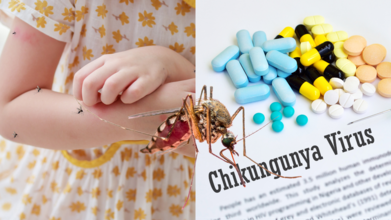- Health Conditions A-Z
- Health & Wellness
- Nutrition
- Fitness
- Health News
- Ayurveda
- Videos
- Medicine A-Z
- Parenting
- Web Stories
UK Health Chiefs Warn of Rising Cases of Deadly Chikungunya Virus That Can Cause Body to ‘Fold In on Itself’

Credits: Canva
Health authorities in the UK have reported a significant rise in chikungunya cases, a mosquito-borne disease known for causing severe joint pain that can leave sufferers hunched over. Between January and June 2025, there were 73 confirmed cases in England, Wales, and Northern Ireland, more than double the 27 recorded during the same period in 2024. The UK Health Security Agency (UKHSA) says this is the highest number ever recorded, with nearly all linked to overseas travel.
What is Chikungunya?
Spread by the bite of infected Aedes mosquitoes, particularly the Aedes aegypti and Aedes albopictus species, chikungunya is not usually deadly but can be devastating for the very young, the elderly, or those with underlying health conditions.
Typical symptoms include:
- Excruciating joint pain that can leave sufferers bent over in agony
- High fever and headaches
- Muscle aches and swelling in the joints (especially hands and feet)
- Nausea, fatigue, and a rash that’s red, bumpy, and decidedly not Instagrammable
In severe cases, the arthritis-like pain can linger for months or even years, turning every movement into a reminder that mosquitoes are not just a mild holiday nuisance.
The majority of UK cases this year were linked to travel to Sri Lanka, India, and Mauritius. All were reported in England, with London taking the dubious honour of having the most cases. However, the two mosquito species that spread the virus are not established in the UK, so there is no risk of it transmitting locally.
UK logs first cases of oropouche virus
As if one virus was not enough, the UK has also logged its first cases of the oropouche virus, also dubbed ‘sloth fever’. This one circulates in the wild between primates, sloths, and birds before occasionally hopping over to humans via midges or mosquitoes.
Found primarily in the Amazon basin, oropouche has recently started wandering further across the Americas. All the UK cases were linked to travel from Brazil, so unless your staycation involves tree-dwelling mammals and tropical insects, you are safe for now.
The Global Bug Crawl
Chikungunya is typically found in Africa and southern Asia, but 2025 has seen it pop up in unexpected places. Outbreaks have been reported in China, the Indian Ocean islands of Reunion, Mayotte and Mauritius, and across the Americas. In southern China, more than 7,000 people have been infected since June, prompting COVID-style lockdowns in Foshan and at least a dozen other cities in Guangdong province. Hong Kong and Taiwan have also reported cases.
Health officials are urging travellers to take bite prevention seriously.
How to safeguard against mosquito bites
According to the US Centres for Disease Control and Prevention (CDC), your best defence is to stop mosquitoes from making contact in the first place.
Top tips include:
- Use Environmental Protection Agency (EPA)-registered insect repellent
- Wear long-sleeved shirts and trousers (mosquitoes can’t bite what they can’t reach)
- Treat clothing and gear with 0.5% permethrin for extra armour
- Choose accommodation with air conditioning or window screens
- If sleeping outdoors, use a mosquito net unless you enjoy sharing your bed with the local insect population
Vaccination
In addition to covering up and dousing yourself in repellent, some travellers may be advised to get the chikungunya vaccine before heading to certain destinations. Your healthcare provider can help you decide if this applies to your travel plans.
Why the Surge Now?
Several factors could be behind the sharp rise in cases. Increased international travel post-pandemic, changing weather patterns favouring mosquito breeding, and outbreaks in popular holiday destinations have created a perfect storm. Mosquitoes thrive in warm, wet conditions, and with climate change extending those conditions into more regions, these viruses are no longer staying politely within their old borders.
Chikungunya virus can turn a dream getaway into a painful endurance test, and once contracted, it is all about managing symptoms; there is no cure. The same goes for oropouche: prevention is your best friend. In the world of tropical diseases, an ounce of repellent really is worth a pound of cure.
WHO Releases New Guidelines To Reduce Deaths From Postpartum Hemorrhage

Credits: Canva
On October 5, 2025, leading reproductive health organisations released new guidelines aimed at transforming how postpartum hemorrhage (PPH) is prevented, diagnosed, and treated. The World Health Organization (WHO), along with the International Federation of Gynecology and Obstetrics and the International Confederation of Midwives, released the new guidelines introducing objective criteria to help identify primary postpartum hemorrhage earlier.
WHO Releases New Guidelines For Postpartum Hemorrhage
According to the researchers, even blood loss below the traditional threshold, when accompanied by abnormal vital signs, can indicate a high risk of life-threatening complications. Traditionally, PPH was defined as blood loss of 500 mL or more. The new guidelines suggest that losses of 300 mL or less, when paired with warning signs, should trigger immediate intervention. Early recognition, they note, could save countless lives.
PPH, or excessive bleeding after childbirth, remains a leading cause of maternal deaths worldwide. In 2023, roughly 45,000 out of 260,000 maternal deaths were linked to PPH. While strategies to prevent and manage PPH exist, their application has often been inconsistent. These updated guidelines aim to provide clear, evidence-based guidance that can inform national and local health policies, clinical protocols, and programmatic strategies.
New Guidelines For Postpartum Hemorrhage
The document consolidates 51 recommendations covering prevention, diagnosis, treatment, supportive care, and health system measures. It also emphasises rapid intervention using the E-MOTIVE bundle, which includes:
- Uterine massage
- Oxytocic drugs to stimulate contractions
- Tranexamic acid to control bleeding
- Intravenous fluids
- Examination of the vagina and genital tract
- Escalation of care if bleeding continues
In rare cases where bleeding persists, the guidelines advise measures such as surgery or blood transfusion to stabilize women until further treatment can be provided.
Alongside the guidelines, WHO and partners, including the United Nations Population Fund have developed training and implementation resources. These tools are designed for frontline health workers, offering practical guidance, simulation-based emergency response training, and materials to help implement best practices at national and sub-national levels.
Jeremy Farrar, WHO assistant director-general for health promotion and disease prevention, highlighted the purpose of the new guidance: “These guidelines are designed to maximise impact where maternal deaths are highest and resources are limited, helping more women survive childbirth and safely return home to their families.”
The world is currently off track to meet Sustainable Development Goal 3, which seeks a global maternal mortality ratio below 70 per 100,000 live births by 2030. By improving understanding of PPH causes and advancing timely interventions, health systems can save lives and address deep inequalities in maternal health.
From this year onward, October 5 will be observed as World PPH Day, sending a strong message: no woman should die from preventable postpartum hemorrhage. Concerted global efforts to prevent and treat PPH can play a pivotal role in reducing maternal deaths and improving health equity worldwide.
Skipping Your First Mammogram May Raise Risk of Breast Cancer Death, Study Finds

Credits: Canva
A new study published in The BMJ suggests that women who skip their first mammogram face a higher risk of being diagnosed with advanced breast cancer and dying from the disease. The research, released on September 24, followed over 400,000 women in Sweden for up to 25 years. As October marks Breast Cancer Awareness Month, the findings highlight the importance of early screening.
Skipping the First Mammogram Can Increase Risk
Since the early 1990s, Sweden has offered regular mammography screenings, which have helped reduce breast cancer deaths. Yet, a significant number of women still choose to skip their first appointment. Researchers wanted to understand the long-term impact of missing this initial screening.
The study analyzed data from the Swedish mammography program and national health registries, covering nearly 433,000 women in Stockholm from 1991 to 2020. About 32 percent of women declined their first screening. Those who missed it were also less likely to attend future screenings, often leading to later-stage diagnoses and worse outcomes.
Women who skipped their first mammogram were more likely to be diagnosed with advanced cancer. The risk of developing stage III breast cancer was about 1.5 times higher, and for stage IV, it was 3.6 times higher than among women who attended their first screening.
Over the 25-year follow-up, nearly 1 percent of women who skipped the first mammogram died from breast cancer, compared with 0.7 percent among those who attended—a 40 percent higher mortality risk. Interestingly, the overall rate of breast cancer development was nearly the same in both groups, around 7.7 percent, indicating that the increased deaths were due to delayed detection, not more cases of the disease.
How Mammograms Affect Breast Cancer Risk?
Mammograms use low-dose X-rays to image the breast. While repeated radiation exposure can slightly increase the risk of cancer, the amount of radiation from mammography is minimal. According to the National Cancer Institute (NCI), the risk is most significant when a person undergoes multiple chest X-rays over time.
A 2016 study examined women aged 40 to 74 who received annual or biennial mammograms, noting that repeated exposure could slightly raise cancer risk, particularly for women with larger breasts. However, both that study and more recent reviews conclude that the benefits of regular mammograms far outweigh the risks. Regulatory bodies like the FDA and the Mammography Quality Standards Act ensure that equipment and radiation levels remain within safe limits.
Early detection remains the key: attending the first mammogram can catch breast cancer sooner, improve treatment outcomes, and ultimately save lives.
Lewis Moody, England Rugby Legend, Diagnosed With Motor Neurone Disease: Are Athletes At Higher Risk?

Credits: Lewis Moody Instagram/Canva
Lewis Moody: Former England captain Lewis Moody revealed on Monday that he has been diagnosed with Motor Neurone Disease (MND). Moody, 47, retired from professional rugby in 2012 after a remarkable 16-year career that included stints with Leicester Tigers, Bath, England, and the British and Irish Lions. The flanker lifted nearly every trophy available and played in some of the most high-stakes matches in rugby history. With his diagnosis now public, many are asking: are athletes more prone to developing MND?
What Is Motor Neurone Disease?
Motor Neurone Disease is a group of neurological disorders that progressively destroy motor neurons, the nerve cells responsible for controlling voluntary muscle movements such as walking, speaking, swallowing, and even breathing.
Messages from the brain’s upper motor neurons are transmitted to lower motor neurons in the spinal cord, which then communicate with muscles. When these signals fail, muscles begin to weaken and shrink, a process called muscle atrophy. Damage to lower motor neurons can also cause stiffness and overactive reflexes, making voluntary movements slow and difficult. Over time, MND can result in the loss of mobility and the ability to control other bodily movements.
Currently, there is no cure for MND. The disease is progressive and worsens over time, but certain treatments and interventions can help manage symptoms and improve quality of life.
Lewis Moody, Motor Neurone Disease: Are Athletes at Higher Risk?
Recent research suggests there may be a link between contact sports and MND. A 2022 study from the University of Glasgow, which examined 400 former Scotland rugby players, found they had a higher likelihood of developing the condition. Additionally, researchers at Durham University discovered that rugby players who suffered repeated concussions exhibited biological differences that could make them more susceptible to MND.
The MND Association notes that while there is a correlation between contact sports and MND, it does not necessarily mean that playing sports causes the disease. The studies indicate a greater prevalence among athletes, but they stop short of establishing a direct cause-and-effect relationship.
Symptoms of Motor Neurone Disease
MND often begins subtly, with symptoms appearing gradually. Early warning signs can include:
- Weakness in legs or ankles, causing difficulty climbing stairs or frequent tripping
- Slurred speech (dysarthria)
- Trouble swallowing
- Weak grip, making daily tasks like buttoning a shirt or opening jars challenging
- Muscle twitches and cramps
- Weight loss from shrinking arm and leg muscles
- Involuntary laughter or crying at inappropriate times (pseudobulbar affect)
Causes of Motor Neurone Disease
The exact cause of MND is not fully understood. It is not contagious and generally arises due to a combination of genetic, environmental, and lifestyle factors. Around 10% of cases are inherited, known as familial MND, caused by a genetic mutation. Children of someone with a genetic mutation have a 50% chance of inheriting it, though not everyone with the mutation will develop the disease.Diagnosing Motor Neurone Disease
There is no single test to diagnose MND. Doctors typically rely on symptom observation and physical examinations. To confirm the diagnosis and rule out other conditions, they may use:
- Electromyography (EMG) and nerve conduction tests
- MRI scans of the brain and spinal cord
- Blood tests
- Muscle biopsies
- Lumbar punctures
© 2024 Bennett, Coleman & Company Limited

